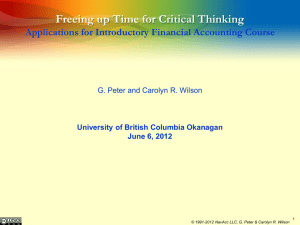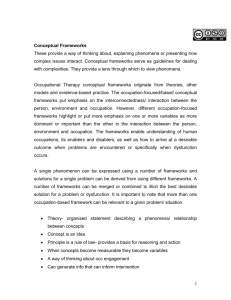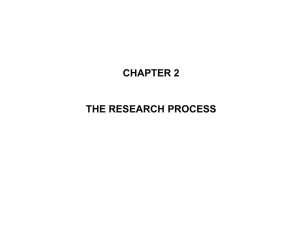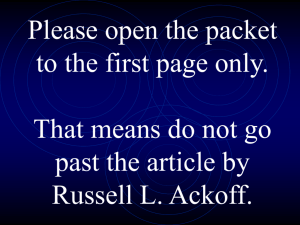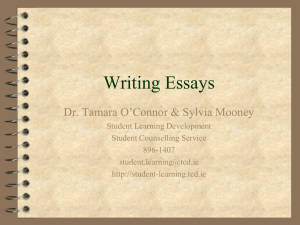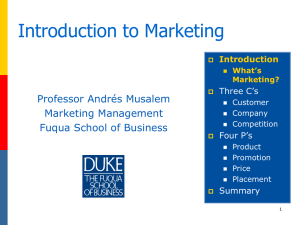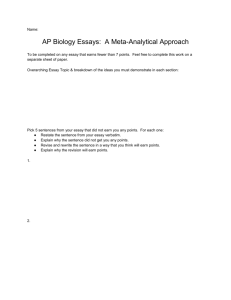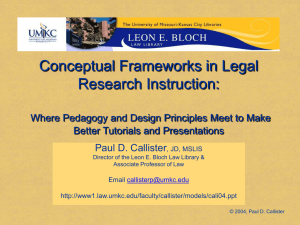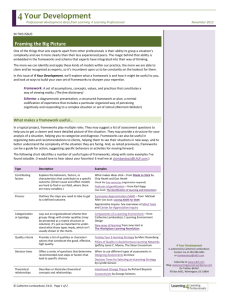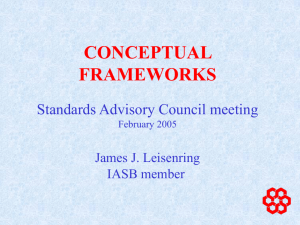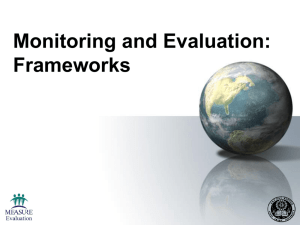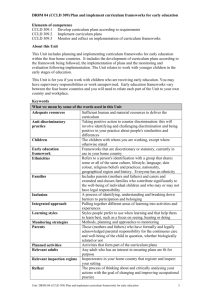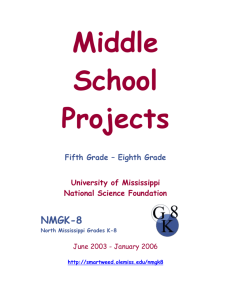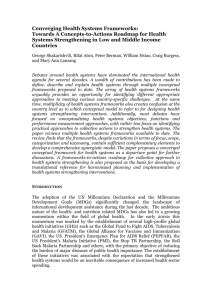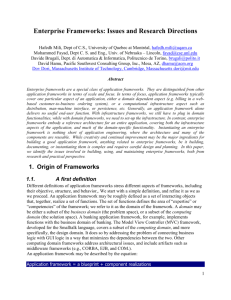Working with Essays and Case Studies
advertisement
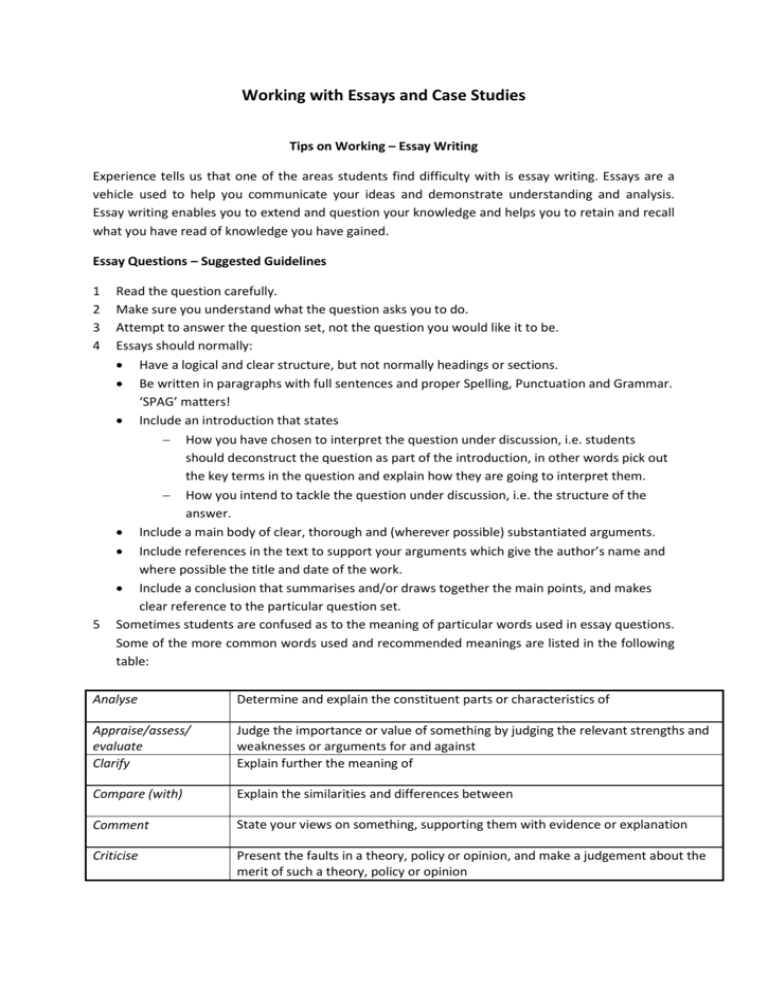
Working with Essays and Case Studies Tips on Working – Essay Writing Experience tells us that one of the areas students find difficulty with is essay writing. Essays are a vehicle used to help you communicate your ideas and demonstrate understanding and analysis. Essay writing enables you to extend and question your knowledge and helps you to retain and recall what you have read of knowledge you have gained. Essay Questions – Suggested Guidelines 1 2 3 4 5 Read the question carefully. Make sure you understand what the question asks you to do. Attempt to answer the question set, not the question you would like it to be. Essays should normally: Have a logical and clear structure, but not normally headings or sections. Be written in paragraphs with full sentences and proper Spelling, Punctuation and Grammar. ‘SPAG’ matters! Include an introduction that states How you have chosen to interpret the question under discussion, i.e. students should deconstruct the question as part of the introduction, in other words pick out the key terms in the question and explain how they are going to interpret them. How you intend to tackle the question under discussion, i.e. the structure of the answer. Include a main body of clear, thorough and (wherever possible) substantiated arguments. Include references in the text to support your arguments which give the author’s name and where possible the title and date of the work. Include a conclusion that summarises and/or draws together the main points, and makes clear reference to the particular question set. Sometimes students are confused as to the meaning of particular words used in essay questions. Some of the more common words used and recommended meanings are listed in the following table: Analyse Determine and explain the constituent parts or characteristics of Appraise/assess/ evaluate Clarify Judge the importance or value of something by judging the relevant strengths and weaknesses or arguments for and against Explain further the meaning of Compare (with) Explain the similarities and differences between Comment State your views on something, supporting them with evidence or explanation Criticise Present the faults in a theory, policy or opinion, and make a judgement about the merit of such a theory, policy or opinion Describe Present the details and characteristics of Discuss Explain the opposing arguments Explain/interpret Set out in detail the meaning of Illustrate Use an example to explain something Tips on Working – Case Studies Many strategic management courses make extensive use of case study materials. Any case presented (or case that a student presents) should be thoroughly analysed and demonstrate a thorough understanding of the issues. Case Studies – General Points The text contains a section on analysing case studies but the following are some general points which are relevant to most case study situations. There are many differing approaches to strategic management, and it is often viewed as a confusing subject area. The approaches can sometimes be contradictory and differing terminology may sometimes be used. However, the textbook follows a fairly traditional and structured approach, and such an approach should normally be applied when reviewing case materials, although other approaches could certainly be considered, and not penalised if used appropriately. A number of conceptual frameworks are considered in the text, including: Porter’s Five Force model of the competitive environment; Value Chain Analysis, the STEEP (Social, Technological, Environmental, Economic, Political/legal) framework, SWOT analysis, the Ansoff Matrix, Boston Consultancy Group Matrix; General Electric Matrix; PIMS; Competitor Profiling, Competitive Group Analysis, Generic Strategy, Cultural and Stakeholder analysis; Investment Appraisal and Financial Analysis. All of these concepts (and others) should be applied to the facts of the case – where it is relevant to do so. If used the points made should be justified by the evidence in the case. In most situations a number of potential answers or strategies are possible and it is difficult to determine categorically whether they are ‘right’ or ‘wrong’ in the usual way. Some answers are clearly wrong. E.g. a company that has increased its turnover by 10 per cent over the last ten years suddenly being expected to triple its turnover over the next three years, when its balance sheet is very weak and the market is contracting. There may, however be several possible ways forward, so to a large extent answers are assessed on the strength of the case presented, i.e. the justifications using the data in the case for a set course of action. The case study should be the sole source of information regarding the organisations concerned, but concepts, frameworks and knowledge derived from academic material can be utilised from any field as long as they are used in a relevant way and applied to the information provided. The information in the case may be selective, incomplete, not labelled and presented in a confusing manner. The information may also bring together learning from other fields and disciplines. These are all difficulties that users of the case have to deal with in the best way that they can, and indeed they reflect the reality of real business situations. It is, however, legitimate to question what information might not included. Case Studies – Key Points A good answer must normally: Identify and prioritise the key issues. Avoid a ‘listing’ approach – where points are not justified. Creatively use conceptual frameworks, e.g. value chain, Ansoff Matrix, Boston Grid; but only introduced where appropriate and appropriately applied to the case. Demonstrate a knowledge and understanding of academic perspectives in the subject area. Be clearly presented with concise and well-argued points. Full justification for points using the case data effectively. Make connections between information contained in different parts of the case. Make calculations where possible and quantify answers where appropriate and possible. Bland or vacuous terms and ‘waffle’ should be avoided. Add value to the case rather than repeat what is contained in it, e.g. by bringing together disparate points in the case, by categorising material, applying concepts, ratios, producing tables and graphs and making calculations, etc. Be case led, i.e. the forms of analysis undertaken, the conceptual frameworks used and the arguments presented should be determined by the type of information that is presented in the particular case being considered. Avoid ‘story telling’, i.e. using the information in the case then introducing material that is not mentioned to make up a story that is not supported by the evidence available. Case Studies – Common Reasons Why Students Lose Marks Application of frameworks tools and techniques/use of references A narrow range of references cited to support arguments and illustrate points. An inappropriate balance between commercial, journalistic and academic references. An over reliance on information supplied by the organisation being studied rather than objective sources. Failure to use the conceptual frameworks. Using frameworks that were not the most appropriate or using them in an inappropriate way. Describing conceptual frameworks without applying them to the circumstances being considered. Level of analysis/Understanding and identification of issues of issues Use of many bland, sweeping or vague statements unsupported by evidence or references. Failure to ask what is not stated or obvious as well as what is. A lack of precision in writing, e.g. use of such words as ‘good’ or ‘bad’, ‘phenomenal’, etc. A failure to question why certain things had happened (or were happening) as well as to describe them. Failure to use latitudinal (comparison with others in the industry) or longitudinal (comparison over time) analysis so as to emphasise comparisons. Failure to ‘add value’ through interpretation of data and information, e.g. calculating market share information from sales figures or ratios from financial accounts. Failure to identify and show understanding of key issues. Material presented without commentary or analysis, thereby not adding value. Presentation standards/Creativity and Innovation Statistics, tables, etc. presented without sources. Diagrams not applied to the facts relating to the organisation being studied. Extensive material downloaded or photocopied and presented as appendices without adaptation, summary or explanation. Lack of tables, diagrams, examples and illustrations. Poor grammar, spelling and expression.

